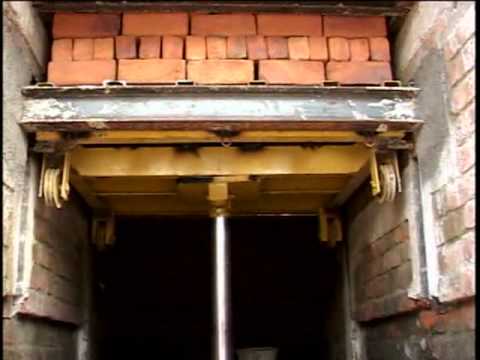Vertical Shaft Brick Kiln
Jump to navigation
Jump to search
About
- developed in China in the late 1960s during the cultural revolution
- updraft kiln for firing bricks
- updraft = heat is reused (cold air entering below cools down the bricks, is then used for firing, then pre-warms up the still-cold bricks on top)
- combines low cost of updraft firing with high fuel economy
- usually fired with low-grade coal fines
- said to be twice as energy efficient as Hoffmann kiln
- firing shaft is very well insulated on all four sides, minimizing heat loss
- bricks are loaded at the top and removed at ground level in a continuous process (see animation below for details)
- operation very similar to that of a vertical shaft lime kiln
- The firing process is completed within a 24-hour period
Videos
vsbk (vertical shaft brick kiln) from sajid on Vimeo.
Related Pages On This Wiki
Pros and Cons vs. Compressed Earth Bricks
Pro:
- no liquid fuel needed (e.g. diesel, ethanol) that would otherwise be required for the CEB press; energy savings due to lower-grade fuel and no need for liquid fuel distillation
- uses low-cost / low-quality fuel such as coal fines or charcoal fines, possibly pyrolysis gas from other processes
- carbon negativity more easily achieved (if part of a Biochar/Brick Co-production System)
- possibility to re-used waste heat (space heating for applications such as greenhouses, fish tanks, etc.)
- no stabilizer needed (e.g. lime, flyash, etc.), leading to energy savings
- reduced wear and tear on the infrastructure per brick (volume is large)
- possibly more stable and more weather-resistant bricks (this requires comparisons, lab testing)
- bricks are of consistently high quality (in fact, they HAVE to be, because of the compressive force that they have to withstand for the stacking)
- likely less work needed per brick for handling (one of the links below describes the labor requirements thusly: "Labour requirements are low, requiring one man to load and two men to unload, during an 8 or 12 hour shift. The labourers are not working continuously, as there are 3 or 4 hours between each loading/unloading session.")
- less need to monitor bricks over weeks (e.g. curing of CEBs with moisture monitoring etc.)
Con:
- possibly increased fuel use per brick (this is not certain, as the VSBK is very efficient, and the fuel use for CEBs is not zero either)
- a larger installation means less flexibility (this facility is not mobile, in contrast to CEB press)
- potential air pollution problems (this is largely a factor of higher volume/concentration of production)
- requirement for continuous operation on nights/weekends (there are breaks though - see labor requirements under "Pro")
- it appears that this approach is only for the production of bricks. Tiles would have to be fired in some other way.
Development Proposal
The standard VSBK is coal-fired (low-quality coal fines). As shown in the animation above (on Vimeo), pieces of coal are scattered onto the bricks from the top. If such a brick kiln were re-designed as part of a pyrolysis system and using just the gas Biochar/Brick Co-production System), what would it look like? How could firing the central bricks be assured if gas enters from the sides?
Further Information (links)
- http://www.swisscontact.org/fileadmin/media/Medienberichte/0913_Vertical_Shaft_Brick_Kiln_VSBK_01.pdf (internal copy: here)
- http://www.fastonline.org/CD3WD_40/GATE_DL/BUILDING/VS/EN/VS.HTM
- http://www.teriin.org/technology/brick-kiln-technology
- Devalt.org: "The Vertical Shaft Brick Kiln : a technology for the masses" (internal copy here)
- Article from GATE - 4/91 - Environmental NGOs Humanity Development Library - The Chinese vertical Brick Kiln
